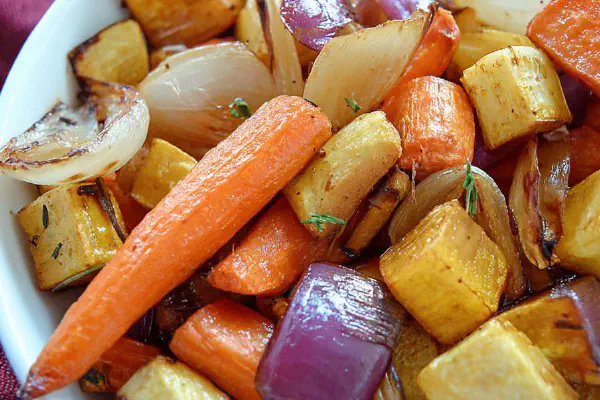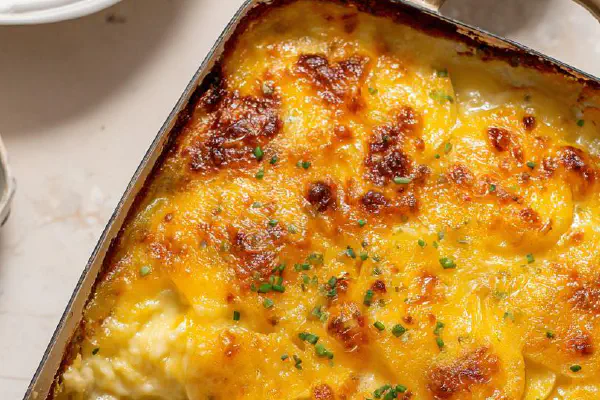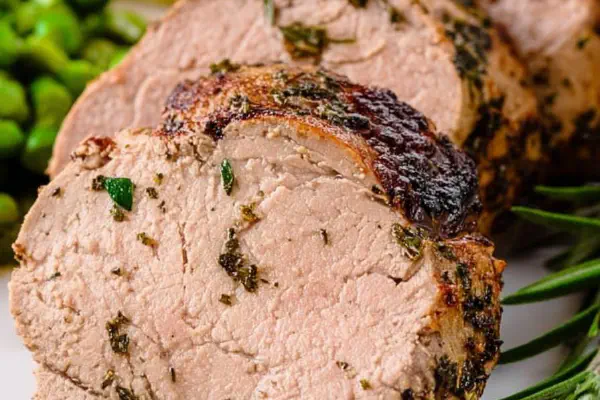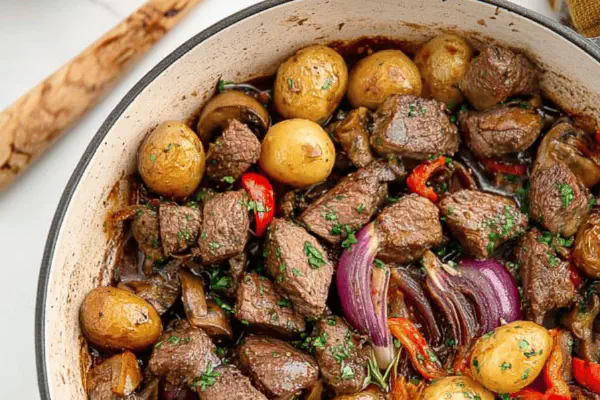Heart Shaped Roasted Potatoes
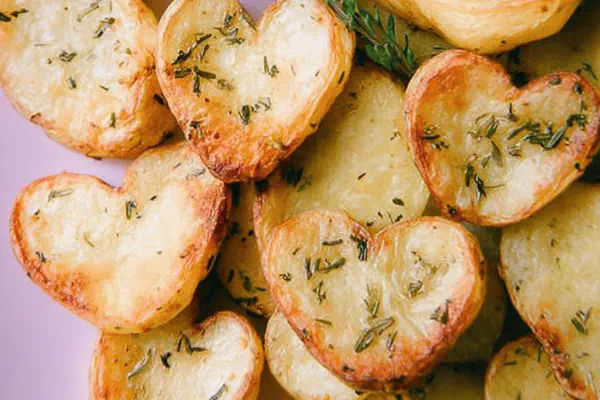
E
By Emma
Certified Culinary Professional
•
Recipe tested & approved
Roasted potato hearts shaped with cookie cutters. Parboiled for soft but firm texture. Coated in garlic-herbed oil mix with Parmesan sprinkle. Oven-roasted till golden brown then broiled to crisp edges. Serve with ketchup or fresh herbs. Simple ingredients swapped: rosemary to thyme for brightness. Timing adjusted slightly for perfect crisp. Visual and tactile cues prioritized over strict timing. Potato scraps used for mash to avoid waste. Prep involves peeling, boiling, cutting, oiling, roasting. Care taken not to overcook in water or oven. Ideal for a snack or side serving 8 people.
Prep:
25 min
Cook:
30 min
Total:
55 min
Servings:
8 servings
#roasting
#potatoes
#savory snacks
#American cuisine
Sometimes shapes change kitchen mood. Heart-shaped potatoes, tactile and visual play for a party or snack. Bland boiled slabs feel common; shape them, soften just enough to keep bite firm. Roasting oil infuses surfaces, garlic and herb aroma tease senses before crunch hits tongue crisp from broiler finishing. I swapped rosemary for thyme here — less woody, more zip. Learned quick boiling is critical; too long and potatoes lose form, too short they’re undercooked. Oil mix rests a few minutes; let flavors soak into crevices. Watch oven closely, broiling seconds make difference between burn and golden crackle. Scraps get second chance as mash — no waste geek move. Ketchup or Parmesan sprinkle finishes, simple yet satisfying. Celebrate potatoes beyond standard wedges.
Ingredients
- 6 large Yukon Gold potatoes
- 3 tablespoons olive oil
- 2 teaspoons fresh thyme leaves
- 1 teaspoon garlic powder
- ½ teaspoon smoked paprika
- 1 ½ teaspoons salt
- Freshly ground black pepper to taste
- ½ cup grated Parmesan cheese
- Nonstick spray or any neutral oil spray
- Water for boiling potatoes
About the ingredients
Yukon Gold chosen for buttery texture and firm body. Russets dry too much, waxy reds slip apart in boiling. Peel thinly — skin can interfere with cutter crispness, but not mandatory if rustic liked. Adjust salt to taste; always season boiling water or potato tastes flat inside. Garlic powder used for consistent level — fresh garlic pieces can sing too strong or burn. Thyme leaf strips picked fresh by hand, woodier stems discarded to avoid bitter twangs. Olive oil specifics matter — choose good quality moderate smoke point variety, avoids bitter burnt oil flavor in oven. Parmesan garnish—not mixed in—to keep that crunchy salty topping intact post-roast. Nonstick spray mandatory, oil alone can stick when heart edges thin. Broiler step optional but really ups texture and flavor dimension — watch intensely. Mulberry cooking tip: repurpose scraps as mash or soup base, zero waste mindset.
Method
- Heat oven to 410 degrees F. Aluminum foil on baking sheet, spray lightly with oil. Two sheets if crowded.
- Fill large pot with 1 ½ quarts water, add 1 teaspoon salt. Bring water to boil then turn heat down to low simmer. Just gentle bubbles.
- Peel potatoes carefully. Slice into ½ inch slabs. If too thin, they break easy. Should hold shape by touch.
- Drop slices into simmering water. Cook 4-5 minutes till slice feels just tender—soft enough to slice with nail, still firm inside. Boil too long and they crumble, too short and crunch prevails.
- Drain immediately. Rinse under cold water to stop cooking. Cools enough to handle, avoids sogginess later in oven.
- Fit as many heart shapes from slices with cookie cutter. Use any leftover scraps for mashed potatoes or discard. Don’t waste starch and bits.
- In bowl, whisk olive oil, thyme, garlic powder, paprika, salt, pepper together. Parmesan held back for last step.
- Toss heart pieces gently in oil. Let sit 4-6 minutes to soak flavor into edges and surfaces. Watch texture change — oil makes them glisten and smell fragrant.
- Arrange potato hearts spaced on sheet. No crowding or steaming happens. Roast in oven 23-26 minutes.
- Flip once halfway through roasting. Watch edges for golden flake. If you hear crackling and smell toasted aroma — roasting right.
- Optional: Shift to broiler on high for an extra 4 minutes to caramelize surfaces, bubbling and darkening edges. Eyes peeled to avoid bitter black spots.
- Remove, sprinkle Parmesan over hot potatoes. Cheese melts slightly into warm surface, adds salty crunch.
- Serve hot, ideal with ketchup or any mustard aioli. Crisp outside, soft inside texture contrast. Aroma of thyme and roasted garlic spices.
- If potatoes feel tough after roasting, oven likely too low or water not sufficient simmer. Adjust simmer intensity next time.
- If surface soggy, oven temp too low or overcrowded tray. Single layer required.
- Scraps boiled again to mash with butter and cream. Double use of potatoes avoids waste.
- No rosemary this round — thyme offers brighter herbal lift. Garlic powder not fresh for ease; fresh crushed garlic can overpower in roast setting.
- Sub olive oil with avocado oil if preferred; both tolerate high heat well.
- Avoid soaking potato slices in water pre-boil; leeches starch and flavor. Quick peel and slice.
- If lacking heart cutter, improvise with small round cutter or knife trimming corners; less whimsical but still appealing.
- This approach relies on tactile and visual signals — finger test after parboil, golden edges on roast. More reliable than clock-watch.
- Prep and roasting times liberal — potato size varies, moisture content fluctuates with season and storage.
Cooking tips
Start with simmer, not roaring boil—gently soften slices; finger press to test readiness. Slice thickness matters—too thin means fragile hearts; too thick means prolonged roasting. Use metal cookie cutters for sharp clean cuts; plastic ones dull edges causing ragged roast finish. Immediate cold rinse after boil stops cooking and firms surfaces for cutting. Oil mix toss essential for uniform flavor, oil acts as heat conductor in roast phase. Letting potatoes sit in oil five minutes improves absorption; oil glistens indicating readiness. Roast on foil for easy cleanup and enhanced crisp edges where potato meets foil surface. Flip carefully to prevent tearing. Broiler on last step caramelizes surfaces; listen for sizzling, smell nutty roasted notes. Final Parmesan sprinkle off heat; melts slightly but preserves texture. Visual cues—golden edges, crackle sound when nudged—guide finish timing better than clock alone. If unsure, test one piece before removing all. Serve warm, quick cool down dulls texture.
Chef's notes
- 💡 Parboil with gentle simmers not roaring boil. Hard bubbles damage slice shape, too short and crunch stays. Finger press test key; should yield slightly but hold firm inside.
- 💡 Use metal cookie cutters only. Plastic dull edges, lead to ragged hearts after roasting. Peel thinly but avoid skin if rustic look preferred. Skin can cause cutter slip or rough edges.
- 💡 After parboil rinse immediately in cold water. Stops cooking fast; avoids soggy texture later in oven. Timing here beats strict clock; texture cues better than watch.
- 💡 Toss oil mix and let slices sit 4-6 minutes. Oil glisten, thyme scent intensifies. This resting soak helps flavor penetrate edges gently without breaking slices.
- 💡 Broil step optional but adds crispy caramelized edges. Watch like hawk; broiling too long burns bitter black spots. Flip once at halfway roasting; golden crackle sound good sign.
Common questions
What if potato slices crumble when boiling?
Boil too long usually. Cut too thin maybe. Try finger test mid-boil. Gentle bubbles. Stop at slight tenderness not mush.
Can I use rosemary instead of thyme?
Rosemary woody can overtake. Thyme lighter, brighter. If using rosemary, chop fine, less quantity. Fresh or dried both OK but potency varies.
How do I prevent soggy roasted potatoes?
Single layer needed. Crowded pans steam, no crisp. Oven too low also culprit. Spray pan lightly with oil or foil for easy lifting and crisp edges.
Can leftovers be stored and reheated?
Store in fridge airtight. Reheat in oven or toaster oven for crisp return. Microwave makes soggy. Use scraps boiled again for mash, zero waste as backup.
